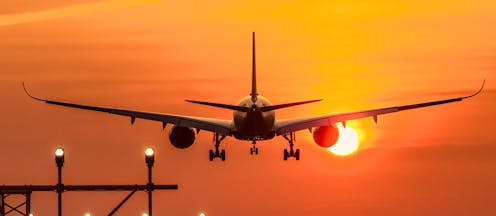Phased border reopening, faster vaccination, be ready for Delta: Jacinda Ardern lays out NZ's COVID roadmap
- Written by Michael Plank, Professor in Applied Mathematics, University of Canterbury

Prime Minister Jacinda Ardern has released a “roadmap” for a phased process of border reopenings that could begin during the first quarter of next year — as long as New Zealand completes its vaccination rollout by the end of this year.
New Zealand’s elimination strategy remains at the centre of the plan, but will shift from the “collective armour” of border restrictions to the “individual armour” of vaccination.
The government is ramping up vaccination and officials are developing a system of travel for fully vaccinated people, based on a risk classification of countries similar to the UK’s red, amber and green lists. A limited self-isolation pilot will start in October to set up and trial new testing and vaccine checking systems at the border.
The announcement follows advice from a strategic COVID-19 advisory group chaired by epidemiologist Sir David Skegg, which recommended New Zealand shouldn’t relax border restrictions until the vaccine rollout is complete.
This is good advice. It will put New Zealand in the best possible position to control the virus before letting it in. There is also a strong equity argument — relaxing border measures before all New Zealanders have had a chance to be fully vaccinated would be unfair on people at the back of the queue, including children.
Modelling work by Te Pūnaha Matatini and similar research overseas have shown vaccination alone will not achieve population immunity. In other words, we will need to continue additional public health measures to prevent a COVID-19 epidemic in New Zealand.
But the higher the vaccine coverage, the more protection we’ll collectively have and the less we’ll have to rely on lockdowns and other distancing measures.
It is tempting to view decisions about border reopening as trade-offs between economic and health benefits. But as we have learned, allowing widespread transmission of the virus isn’t a trade-off but a lose-lose situation.
The Delta variant is wreaking havoc and threatening reopening plans in countries around the world. Any economic gains from international travel would be quickly wiped out if we had an uncontained outbreak of the Delta variant in New Zealand.
More outbreaks are inevitable
The Skegg report is clear that, once international travel resumes, outbreaks will be inevitable and we’ll need to be ready to stamp them out. The challenges of doing this will be formidable and should not be underestimated.
As a hypothetical example, suppose we allowed quarantine-free travel from countries with fewer than ten new daily cases per million people. In the global context, this is quite a low limit and way below the current levels in most countries in Europe and North America.
We also have to think about the number of people travelling. At the moment around 2500 people arrive in New Zealand per week, but the introduction of quarantine-free travel could see this number increase dramatically. Let’s suppose this went up to 50,000 arrivals per week, which is around half the pre-pandemic travel rate.
In this scenario, we could get about seven infected people arriving in New Zealand every week. The Skegg report recommends vaccination and pre-departure and arrival testing as requirements for travel. As a rough estimate, let’s suppose these measures reduce the risk of an outbreak in a population with high vaccine coverage to about 5% per infected arrival. This means we could expect a new outbreak to occur around once every three weeks.
If our vaccine coverage is high enough, we may be able to contain most of these outbreaks with targeted measures like testing and contact tracing. Even then, it’s likely some of these outbreaks will need broader restrictions or even localised lockdowns to bring them under control. This will be especially likely during the winter months when the virus spreads more easily, or if the outbreak gets into a population group with low vaccination rates.
Caution while uncertainty remains high
Te Pūnaha Matatini’s model estimates that, even with 90% coverage of people over 15, an uncontrolled outbreak of the Delta variant could still potentially cause thousands of deaths and threaten to overwhelm our healthcare system. This means we need to prevent uncontrolled spread of the virus and sticking with a “stamp it out” strategy gives us the best shot at doing that.
Whether this will ultimately succeed is uncertain. But as the Skegg report notes, it is easy to switch away from an elimination approach if it becomes apparent that the costs are too high. But once you’ve abandoned elimination, it is virtually impossible to get it back.
Given this uncertainty, it makes absolute sense to take a cautious and gradual approach to relaxing travel restrictions rather than throwing the borders open quickly. We will need to see how our systems cope with a small influx of travellers from low-risk countries before considering a wider reopening.
Read more: Is Delta defeating us? Here's why the variant makes contact tracing so much harder
This also shows why it’s unrealistic to expect a detailed timeline for resuming international travel at this stage. There are too many uncertainties around the level of vaccine coverage, how our systems will cope with managing COVID-19 outbreaks in the community, and whether we’ll be facing another new variant. Most importantly, it’s hard to predict which countries will have the virus under control months in the future.
In the meantime, it’s becoming clear the choice is not simply whether to get vaccinated or not. The choice is between getting vaccinated or getting COVID-19. We now have a wealth of evidence that getting vaccinated is by far the safer of these options. It also contributes to a collective immunity that will give us the best chance of resuming international travel safely.
Authors: Michael Plank, Professor in Applied Mathematics, University of Canterbury





